AI has transformed the way we do marketing. You can now use AI platforms like ChatGPT, CoPilot, Gemini, or Claude to carry out daily tasks more efficiently, freeing up time for work that requires human experience and expertise.
In this post, I will discuss 5 practical examples of using AI to conduct market research, generate email marketing campaigns, write copy, and more. The advice comes directly from Google, as explained by Justine, a Marketing Manager at Google, in the Google Digital Marketing & E-commerce certificate.
1. Use AI to Understand Your Audience Better
Defining your target audience is one of the first steps in any marketing campaign. This ensures that you target people most likely interested in your product or service, making your marketing relevant and cost-effective.
AI can help you understand your audience in two ways.
If you already have data from surveys, focus groups, or other research methods, AI can help you process it faster and more efficiently.
Instead of manually segmenting the data, you can ask AI to analyze it and identify key audience segments, their preferences, and even unmet needs.
Another way to use AI is to use it as the starting point of your audience research.
For example, if your company is considering launching a new line of affordable sneakers, you could use a prompt like this:
“I’m a marketer, and my company is exploring the idea of branching out into sneakers for adults. Analyze the target market for inexpensive everyday shoes. What are their demographics and spending habits for purchasing sneakers and other shoes?”
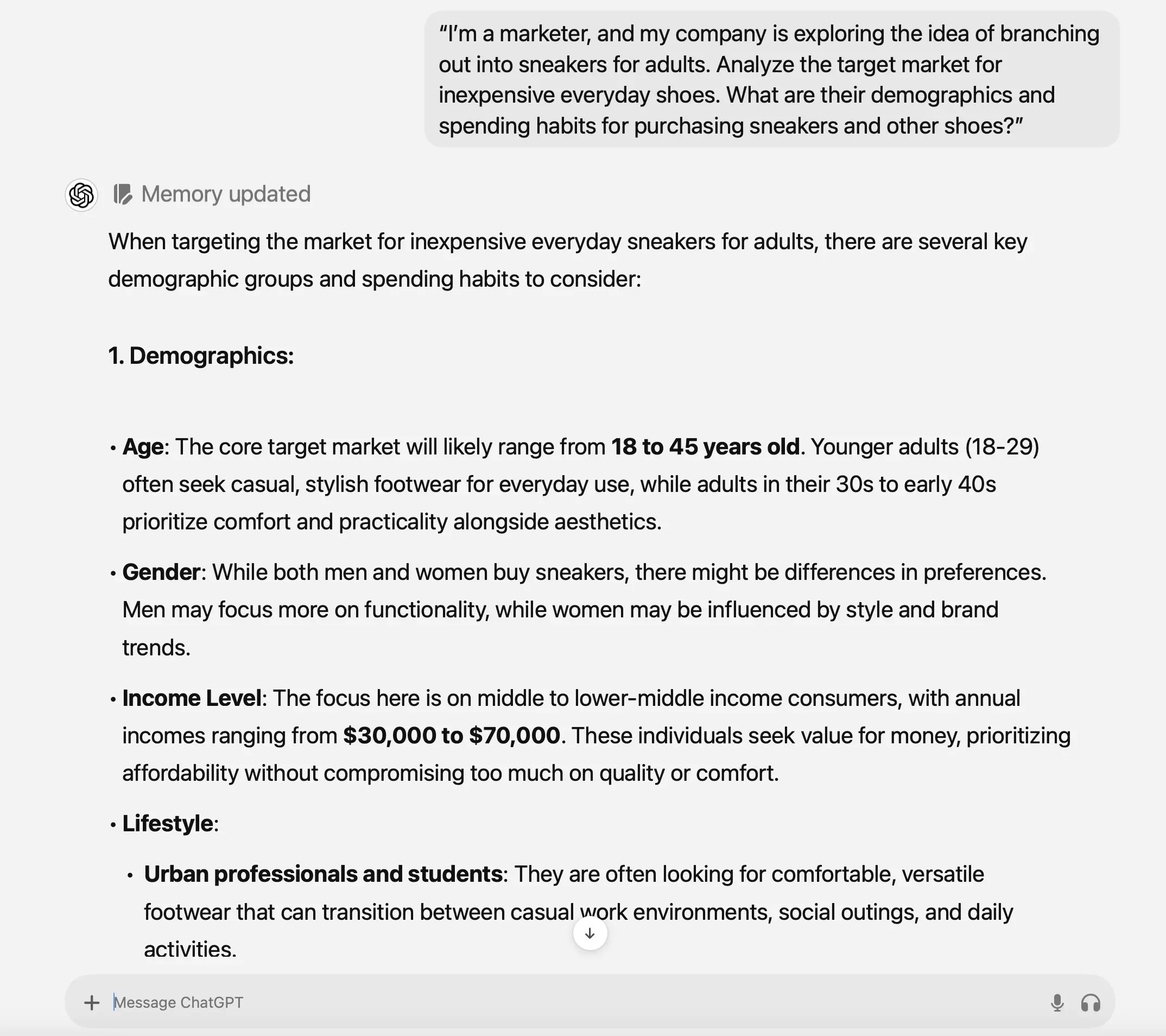
The result is not perfect, but it's a great starting point for creating your marketing plan.
You can keep the parts you want and ask AI to clarify, expand, or even re-think specific parts.
For example, you can ask AI to create buyer personas in a follow-up prompt.

2. Use AI to Develop a Marketing Strategy For a New Product
No matter how many times you've done this before, creating a digital marketing strategy for a new product launch is always challenging.
AI can play the role of a creative partner and help you kickstart the process, generate ideas, and refine your strategy.
Let’s say you’re launching a new mobile app that recommends books to readers based on their reading history. You’ve already done your research, and you know your target audience: adults aged 21 to 60 who love to read. But now, you need a strategy to reach them and get them excited about the app.
For instance, you could use a prompt like this:
“I’m a marketer, and I want to create a marketing plan for a new product my team is launching. Our product is an app that recommends new books to users based on their reading history, and our target audience is adults ages 21 to 60 who are avid readers. Please help me develop an initial marketing plan for this product. My company has a team dedicated to marketing for social media, so I’m specifically looking for ideas, including messaging, that resonate with this audience in other channels.”
Notice you're giving the AI enough context to provide specific, useful suggestions. You’re telling it what the product is, who it’s for, and what marketing channels interest you.
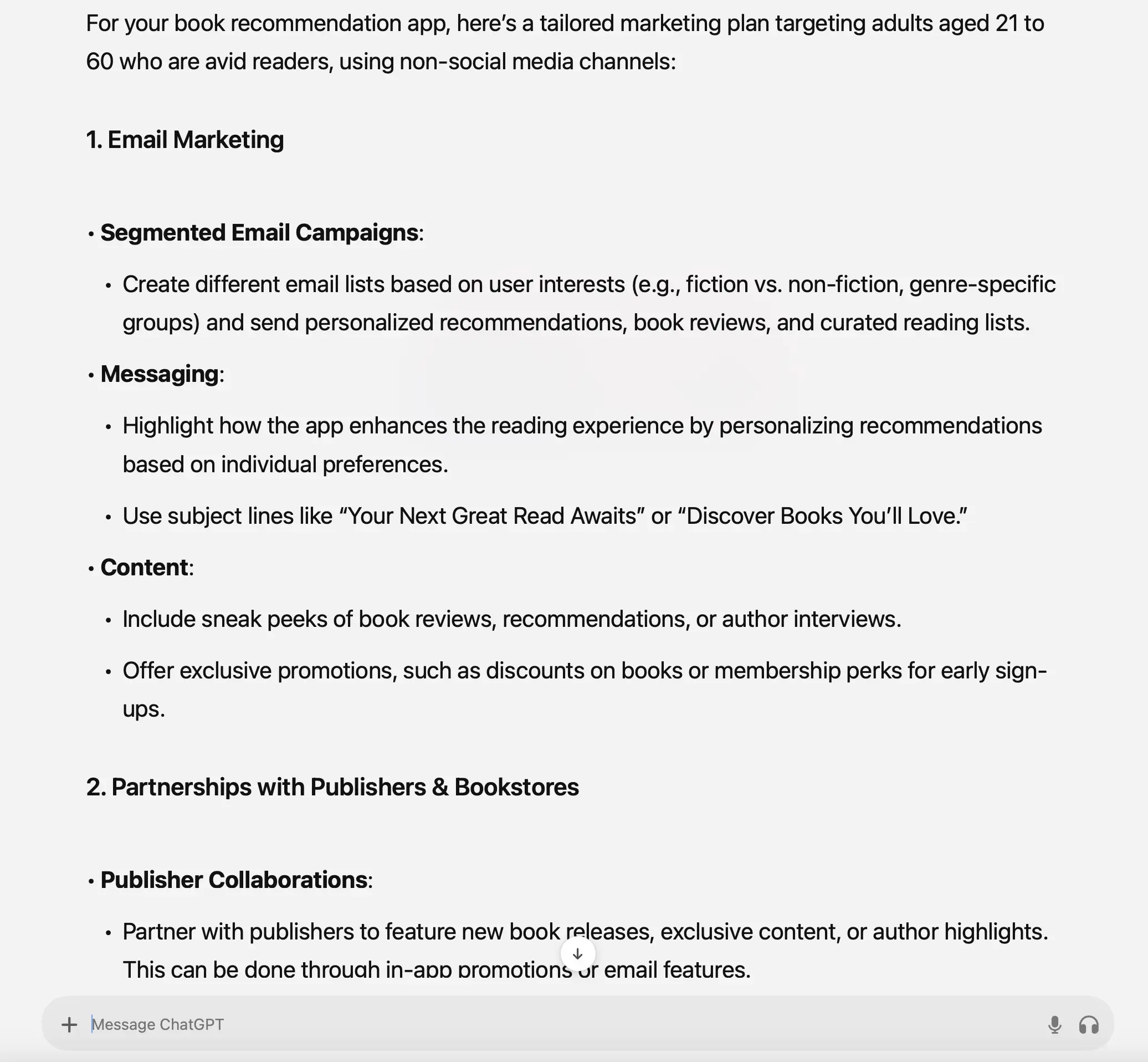
As you can see above, ChatGPT came up with some nice ideas, such as segmenting email campaigns, partnering with local bookstores, and reaching out to influencers.
You can ask AI for more details on these ideas or even create a list of businesses to contact.
Don't forget to utilize the unique capabilities of each AI tool to your advantage.
For example, Gemini can do a better job than ChatGPT when you want data from Google products (such as Google Maps), so using a combination of AI platforms can generate higher-quality results.
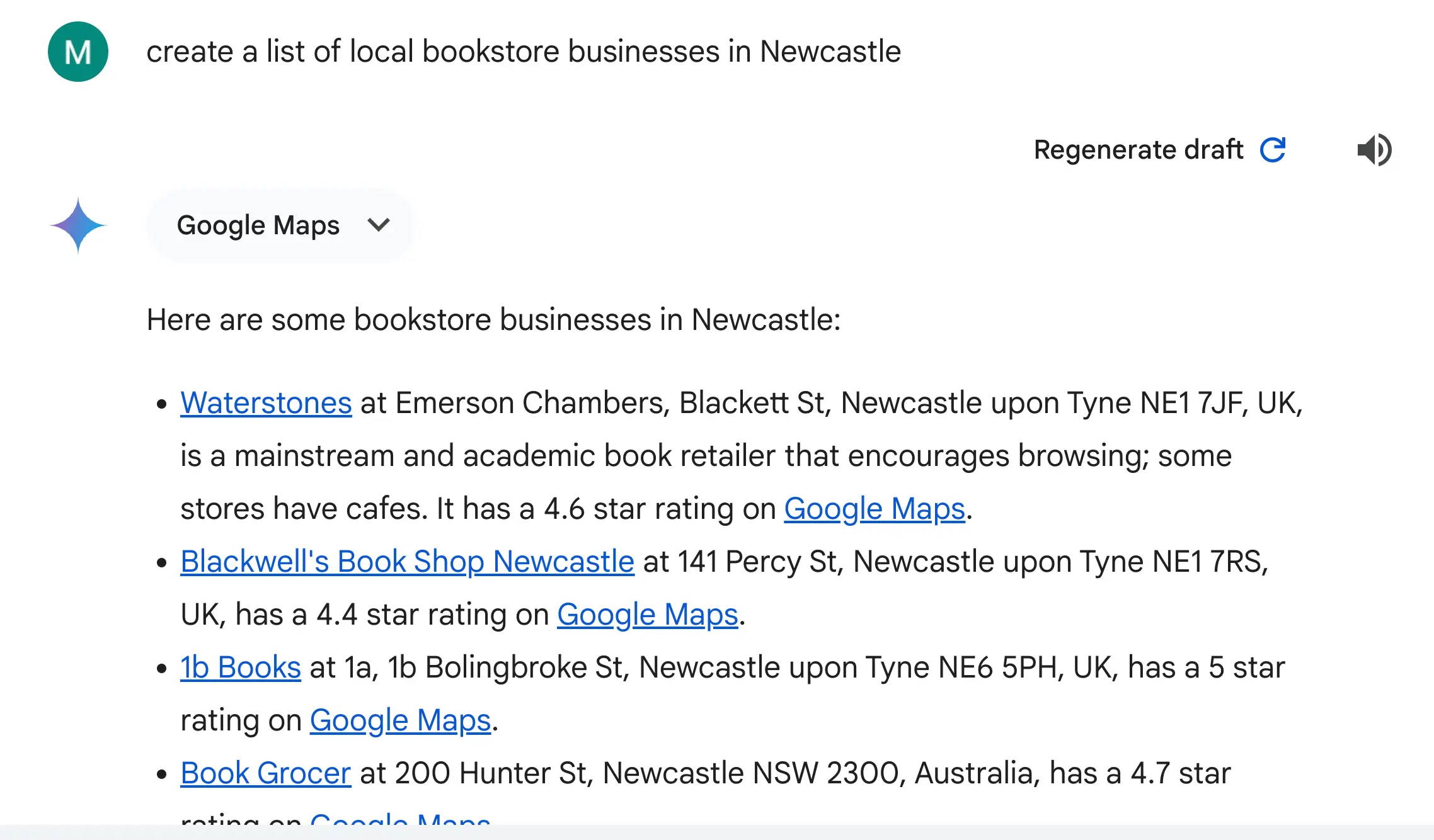
Also, the best way for tasks requiring multiple steps is to use multiple prompts instead of one big prompt.
In our example, once you get the initial ideas back, concentrate on one idea at a time and ask additional questions. Always give feedback on how the AI is performing. Tell it what is good and explain why something is not working for your brand.
3. Use AI to Evaluate Campaign Ideas And Create Copy For A/B Testing
When setting up a new social media or PPC campaign, you usually have several ideas, each targeting a different style and theme. When you're stuck deciding which direction to go, you can ask AI to evaluate your ideas and give you unbiased feedback.
Providing generative AI with all the details can help you see things from a different angle and identify gaps you could not spot otherwise.
Let's imagine you are working for a company that makes reusable water bottles. You are trying to decide between two marketing campaigns:
Campaign A, "Hydrate for the Planet," emphasizes the environmental benefits of using reusable bottles. It features images of beautiful natural landscapes and emphasizes the negative impact of single-use plastic bottles.
Campaign B: "Style Your Hydration" focuses on reusable bottles' stylish designs and colors. It features images of people looking fashionable while carrying your bottles and emphasizes the variety of colors and designs available.
AI tools can help you evaluate your options by analyzing the strengths and weaknesses of each campaign. You can easily prompt the AI with something like:
“I am a marketer working for a company that makes reusable water bottles. I’m trying to decide between two social media campaign ideas. Here are the details of the first campaign [enter details for Campaign A]. Here are the details of the second campaign [enter details of Campaign B]. Please help me evaluate the advantages and disadvantages of each campaign in a clear, structured format. Also, include additional considerations I should keep in mind.”
As you can see in the response, AI creates a list of each campaign's advantages and disadvantages and also provides an 'Additional Considerations' section that combines both ideas and highlights areas you should consider.
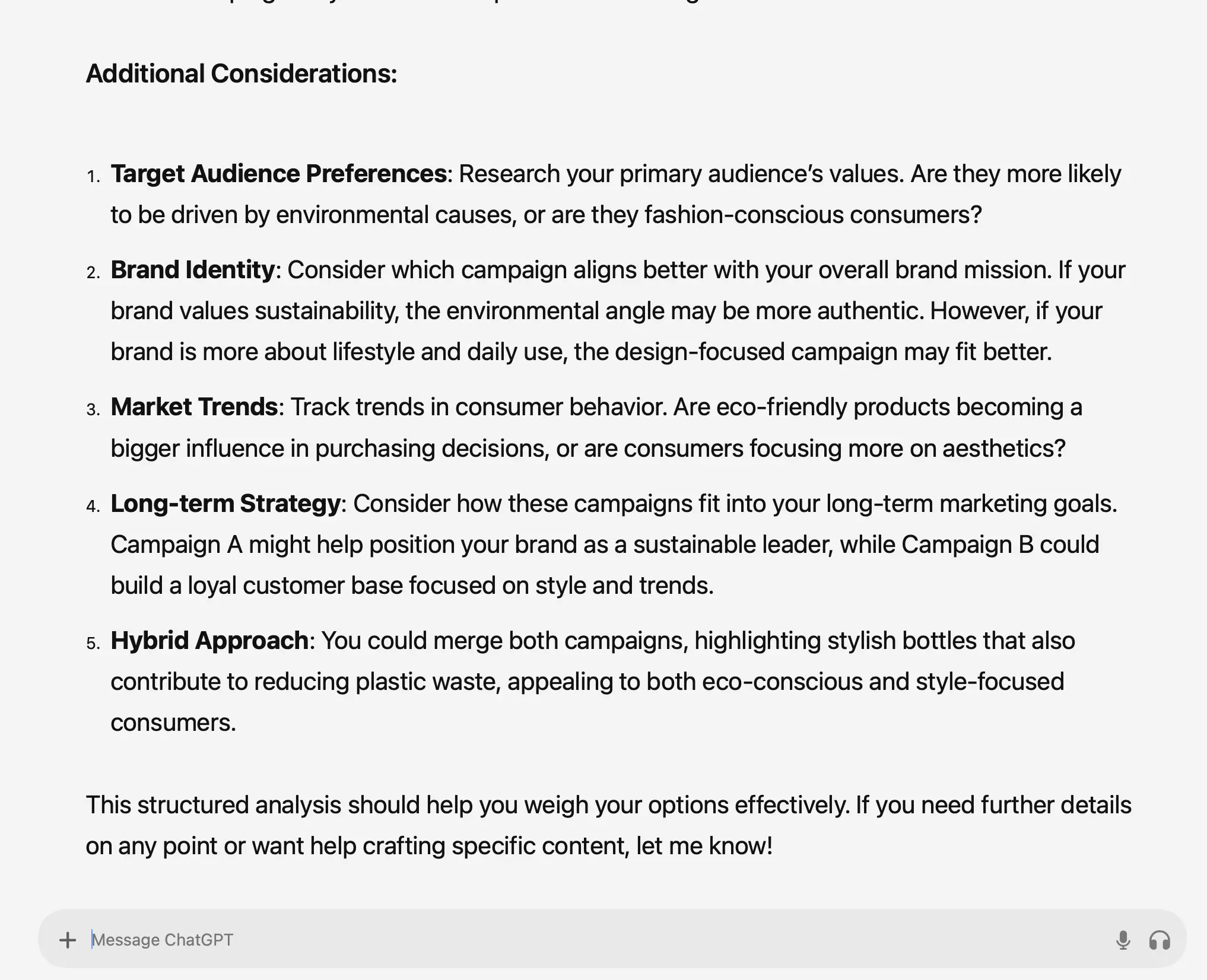
Once you agree on the campaign format, you can ask AI to create several ad copies for specific platforms, perform A/B testing, and decide which resonates best with your audience.
4. Use AI to Create Customized Email Campaigns
Email marketing is still one of the most effective ways to engage with your audience, drive engagement, and boost sales.
But if you’re like me, creating compelling email content week after week can start to feel a bit draining. This is where AI can help develop unique ideas to beat writer's block and speed up the time needed to write email copy.
Let’s say you need to write a newsletter for your customers. Instead of starting from scratch, ask AI to create email template ideas.
The key to getting good results is always the same. You need to provide AI with details of what exactly you're trying to do and what you want to achieve.
Here is an example prompt to get you started:
“I’m a marketer working at a nonprofit organization. We are developing a monthly newsletter for donors, volunteers, and supporters. Help me create a template that covers impact reports, volunteer opportunities, fundraising campaigns, event invitations, success stories, and financial transparency. The newsletter should be about 1,000 words with images or video content placeholders. Provide four templates for me to choose from.”
This detailed prompt will give you templates tailored to your specific needs. You can easily customize these templates, incorporating your brand’s voice and adjusting the structure to fit your organization’s goals.
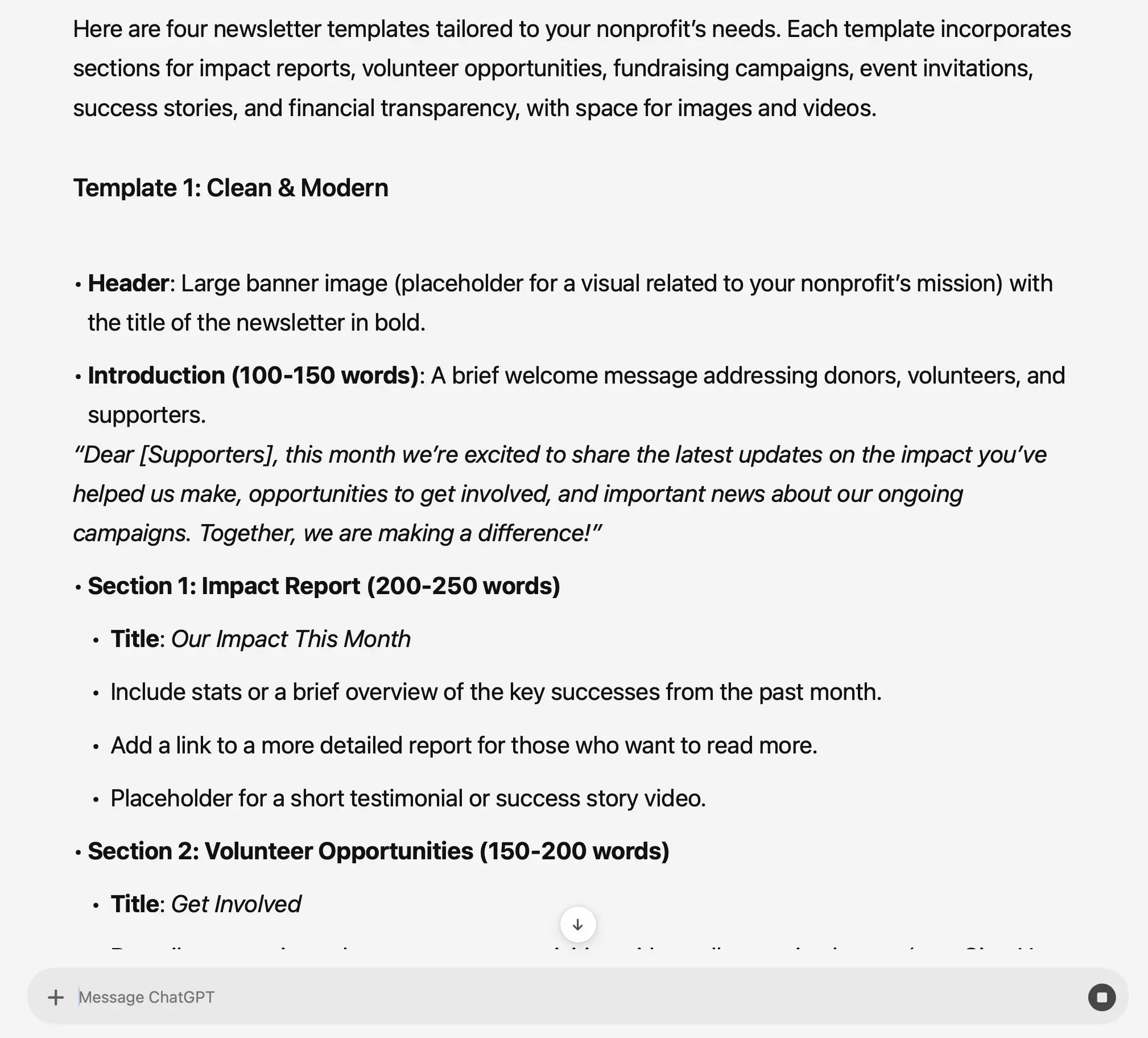
AI doesn’t just stop at helping you create templates. You can also use it to brainstorm engaging subject lines, test different email versions through A/B testing, and even proofread your final drafts for clarity and impact.
5. Use AI To Brainstorm Website Copy Ideas
I've already given examples of how AI can help you write emails and create ad copy, tasks that marketers spend a lot of time on. Another area that consumes a lot of time is writing website copy. Whether it is blogs, product pages, or PPC landing pages, coming up with the right words is sometimes exhausting.
Fortunately, generative AI models excel in this area because they are trained on vast data. With the right prompt, they can help you brainstorm ideas, refine existing content, and even test different versions to see what resonates best with your audience.
Let’s say you work for an online academy that sells courses. You need to update your Facebook Ads Course landing page.
Besides telling AI what you want, you can also ask it to review the existing text, create new drafts, and compare their differences.
Your prompt might look like this:
I am a digital marketing specialist, and I need to update my company’s website, which specializes in digital marketing courses. My team has drafted landing page copy for a campaign aimed at promoting our Facebook Ads Course, which is copied below. Help me generate two additional versions of this copy so that the three drafts can be A/B tested. For each additional version, add a paragraph that identifies the differences from the other drafts.
Here is what the full prompt looks like:
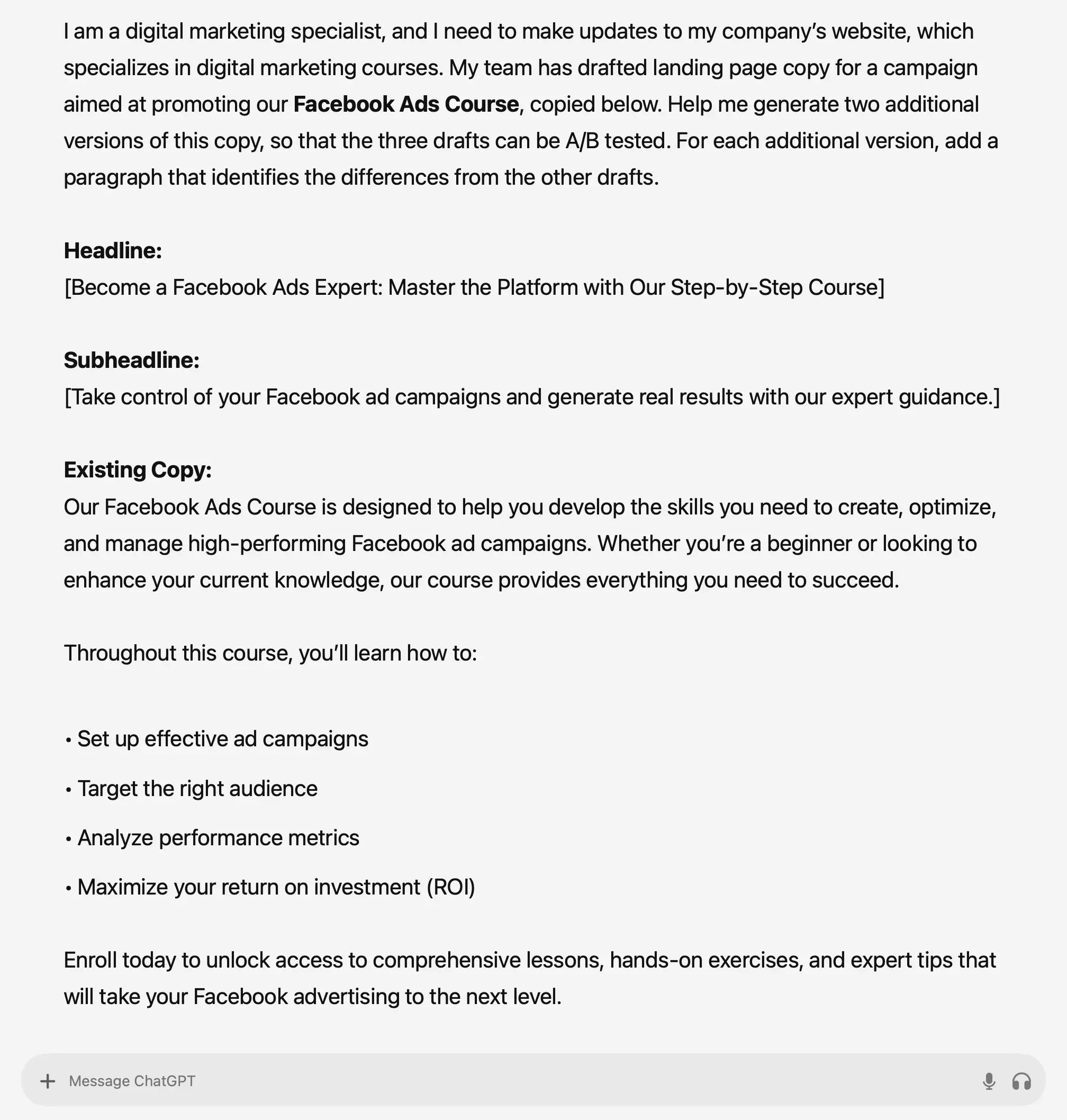
This is the reply:
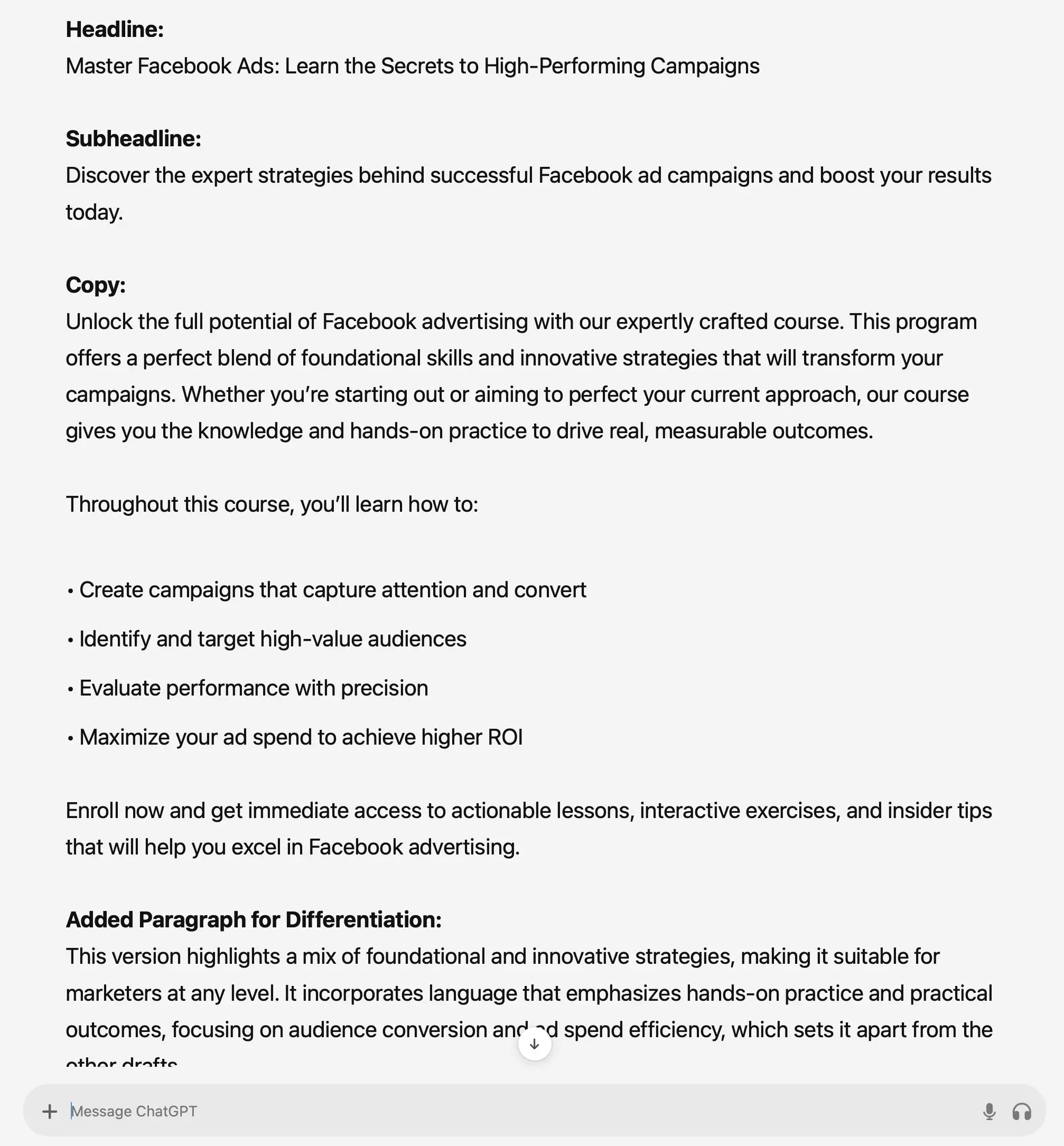
AI followed the instructions precisely and came up with ideas you can certainly use to improve your website's copy.
Using Gen AI to Work Smarter And Faster
All the examples shared above have two things in common.
First, AI can deliver good results with the right information and prompt.
Second, human intervention is still needed to guide the process, evaluate the results, and add elements that Gen AI models lack, such as experience and expertise.
Marketers shouldn't be afraid to use AI. Instead, they should experiment with Generative AI platforms to find tasks that AI can help them become faster and more efficient in their work.



